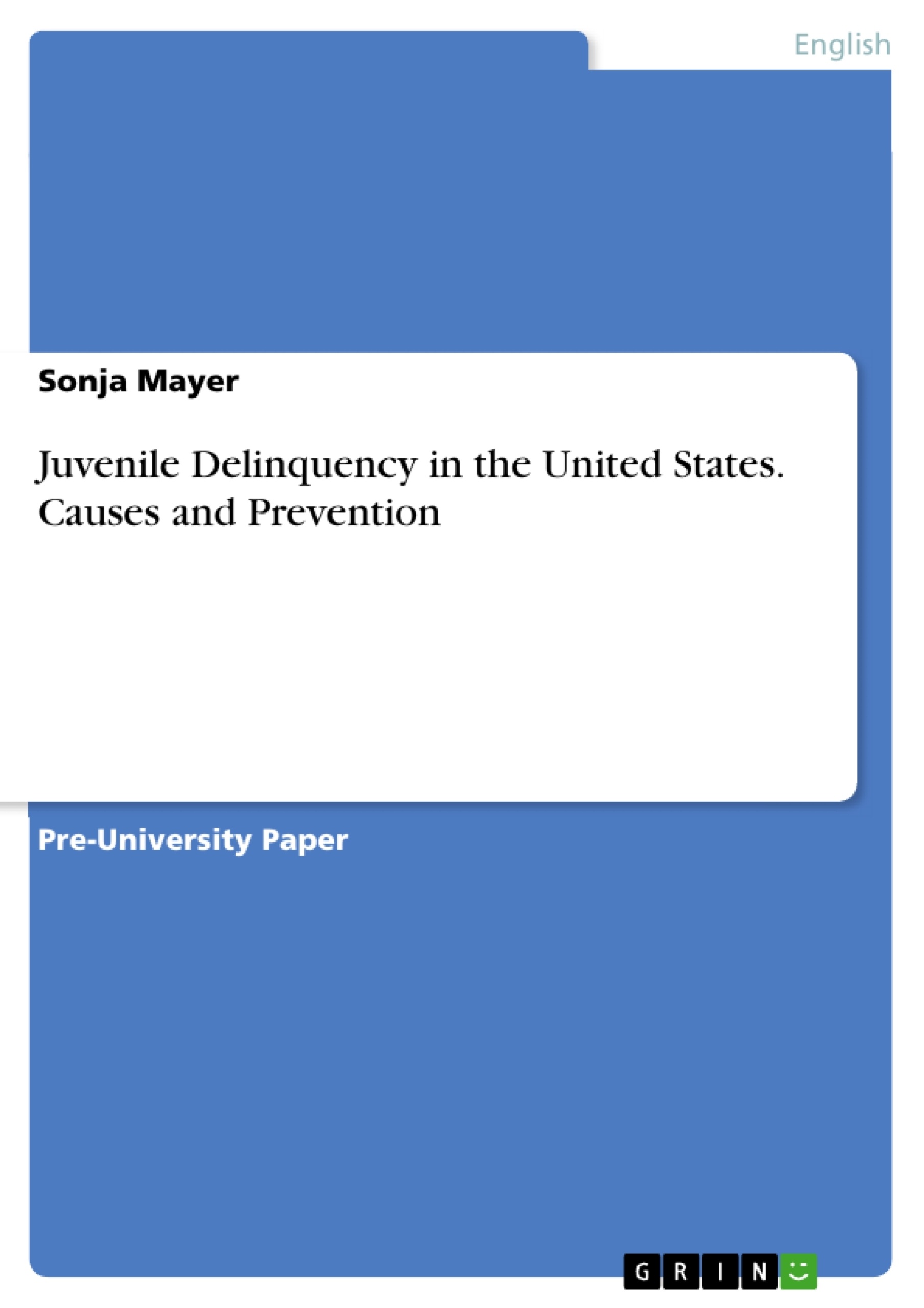This research paper makes an attempt to take a closer look at the risk factors of juvenile delinquency and introduces prevention measures that have been either proven effective or ineffective regarding their outcomes
However, readers who wish to find definite answers to the questions concerning this topic will be disappointed, as there are no answers, which would explain the individual criminal deed of every single adolescent.
Juvenile delinquency is an issue that should address all of us, because it harms entire communities, causes a culture of fear and ruins the careers of minors who are the most in need of support.
Because gang violence and school shootings are both very particular sub-points of juvenile delinquency and are based on other risk factors and theories than the common ones, these two issues are excluded from the available research paper as they would require to much detailed knowledge on this criminological field.
Table of Contents
- A.) INTRODUCTION
- B.) JUVENILE DELINQUENCY IN THE U.S. - CAUSES AND PREVENTION
- I.) TERM
- 1.) Definition
- 2.) Crime Categories
- 3.) Topical Figures
- II.) RISK FACTORS IN GENERAL
- Gender
- Race
- Socio-Economic Situation of the Family
- Family Composition
- Parent Child - Relations
- Child maltreatment
- Substance Abuse
- Parental criminality
- III.) PREVENTION AND INTERVENTION IN GENERAL
- 1.) Three different approaches to prevention
- 2.) Three different age groups
- 3.) Examples of different prevention measures
- C.) CONCLUSION
Objectives and Key Themes
This research paper aims to examine the risk factors associated with juvenile delinquency in the U.S. and to explore prevention and intervention measures. It avoids the complexities of gang violence and school shootings, focusing instead on a broader understanding of the issue.
- Definition and scope of juvenile delinquency
- Risk factors contributing to juvenile delinquency
- Prevention and intervention strategies for juvenile delinquency
- The limitations of current understandings of juvenile delinquency
- The disparity in legal definitions and consequences across states
Chapter Summaries
A.) Introduction: This introductory chapter sets the stage by highlighting the public's often-misinformed and sensationalized perception of juvenile delinquency. It emphasizes the need for a more nuanced understanding of the issue, acknowledging the vast majority of juvenile offenses are not violent or serious. The chapter establishes the paper's objective: to delve into the risk factors of juvenile delinquency and explore effective prevention strategies, while acknowledging the limitations of attributing specific causes to individual criminal acts.
B.) Juvenile Delinquency in the U.S. - Causes and Prevention: This chapter offers a detailed examination of juvenile delinquency, beginning with a discussion on defining the term itself. The difficulties of creating a universally applicable definition are highlighted, due to variations in age of criminal responsibility across different states and the complex spectrum of behaviors classified as delinquent. The chapter further divides offenses into categories, differentiating between serious and violent juvenile offenders (SVJ) and less serious offenses. Statistical data illustrating the increasing trend in juvenile crime are presented. Finally, the chapter lays the groundwork for exploring various risk factors associated with juvenile delinquency.
Keywords
Juvenile delinquency, risk factors, prevention, intervention, crime categories, serious and violent juvenile offenders (SVJ), age of criminal responsibility, status offenses, United States, public perception.
Frequently Asked Questions: A Comprehensive Language Preview on Juvenile Delinquency in the U.S.
What is the overall purpose of this research paper?
This research paper aims to examine the risk factors associated with juvenile delinquency in the United States and to explore effective prevention and intervention measures. It focuses on a broader understanding of the issue, avoiding complexities like gang violence and school shootings.
What topics are covered in the "Table of Contents"?
The Table of Contents includes an introduction, a section on juvenile delinquency in the U.S. (covering the term's definition, crime categories, relevant statistics, general risk factors like gender, race, socioeconomic status, family dynamics, substance abuse, and parental criminality), a section on prevention and intervention strategies (including different approaches and age groups), and a conclusion.
What are the key themes explored in the paper?
Key themes include the definition and scope of juvenile delinquency, risk factors contributing to it, prevention and intervention strategies, limitations of current understandings, and disparities in legal definitions and consequences across different states.
What is the main point of the introduction chapter?
The introduction highlights the often-misinformed and sensationalized public perception of juvenile delinquency. It emphasizes the need for a nuanced understanding, acknowledging that most juvenile offenses are not violent or serious. It establishes the paper's objective: to explore risk factors and prevention strategies while acknowledging limitations in attributing specific causes.
What does the chapter on Juvenile Delinquency in the U.S. cover?
This chapter details juvenile delinquency, starting with defining the term and highlighting the difficulties due to variations in age of criminal responsibility and the complex spectrum of delinquent behaviors. It categorizes offenses (differentiating between serious and violent juvenile offenders and less serious offenses), presents statistical data, and explores risk factors.
What types of risk factors are discussed in the paper?
The paper discusses a wide range of risk factors, including gender, race, socioeconomic situation of the family, family composition, parent-child relations, child maltreatment, substance abuse, and parental criminality.
What kinds of prevention and intervention strategies are considered?
The paper explores prevention and intervention strategies across three different approaches and three different age groups, although specific examples of measures are not detailed in the preview.
What are the key limitations acknowledged in the paper?
The paper acknowledges limitations in attributing specific causes to individual criminal acts and highlights the disparity in legal definitions and consequences across different states.
What keywords are associated with this research paper?
Keywords include juvenile delinquency, risk factors, prevention, intervention, crime categories, serious and violent juvenile offenders (SVJ), age of criminal responsibility, status offenses, United States, and public perception.
- Quote paper
- Sonja Mayer (Author), 2009, Juvenile Delinquency in the United States. Causes and Prevention, Munich, GRIN Verlag, https://www.grin.com/document/210853



